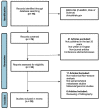Application of Artificial Intelligence Methods for Imaging of Spinal Metastasis
- PMID: 36011018
- PMCID: PMC9406500
- DOI: 10.3390/cancers14164025
Application of Artificial Intelligence Methods for Imaging of Spinal Metastasis
Abstract
Spinal metastasis is the most common malignant disease of the spine. Recently, major advances in machine learning and artificial intelligence technology have led to their increased use in oncological imaging. The purpose of this study is to review and summarise the present evidence for artificial intelligence applications in the detection, classification and management of spinal metastasis, along with their potential integration into clinical practice. A systematic, detailed search of the main electronic medical databases was undertaken in concordance with the PRISMA guidelines. A total of 30 articles were retrieved from the database and reviewed. Key findings of current AI applications were compiled and summarised. The main clinical applications of AI techniques include image processing, diagnosis, decision support, treatment assistance and prognostic outcomes. In the realm of spinal oncology, artificial intelligence technologies have achieved relatively good performance and hold immense potential to aid clinicians, including enhancing work efficiency and reducing adverse events. Further research is required to validate the clinical performance of the AI tools and facilitate their integration into routine clinical practice.
Keywords: applications; artificial intelligence; deep learning; imaging; machine learning; spinal metastasis.
Conflict of interest statement
The authors declare no conflict of interest.
Figures





Similar articles
-
Oncologic Applications of Artificial Intelligence and Deep Learning Methods in CT Spine Imaging-A Systematic Review.Cancers (Basel). 2024 Aug 28;16(17):2988. doi: 10.3390/cancers16172988. Cancers (Basel). 2024. PMID: 39272846 Free PMC article. Review.
-
Current Applications of Machine Learning in Spine: From Clinical View.Global Spine J. 2022 Oct;12(8):1827-1840. doi: 10.1177/21925682211035363. Epub 2021 Oct 10. Global Spine J. 2022. PMID: 34628966 Free PMC article. Review.
-
Application of Machine Learning for Differentiating Bone Malignancy on Imaging: A Systematic Review.Cancers (Basel). 2023 Mar 18;15(6):1837. doi: 10.3390/cancers15061837. Cancers (Basel). 2023. PMID: 36980722 Free PMC article. Review.
-
Artificial Intelligence in Head and Neck Cancer: A Systematic Review of Systematic Reviews.Adv Ther. 2023 Aug;40(8):3360-3380. doi: 10.1007/s12325-023-02527-9. Epub 2023 Jun 8. Adv Ther. 2023. PMID: 37291378 Free PMC article.
-
Artificial Intelligence in Oncological Hybrid Imaging.Rofo. 2023 Feb;195(2):105-114. doi: 10.1055/a-1909-7013. Epub 2022 Sep 28. Rofo. 2023. PMID: 36170852 Review. English.
Cited by
-
Current Trends in Artificial Intelligence-Assisted Spine Surgery: A Systematic Review.Asian Spine J. 2024 Feb;18(1):146-157. doi: 10.31616/asj.2023.0410. Epub 2023 Dec 22. Asian Spine J. 2024. PMID: 38130042 Free PMC article.
-
Role of artificial intelligence in oncologic emergencies: a narrative review.Explor Target Antitumor Ther. 2023;4(2):344-354. doi: 10.37349/etat.2023.00138. Epub 2023 Apr 28. Explor Target Antitumor Ther. 2023. PMID: 37205309 Free PMC article. Review.
-
Exploring the Potential of a Deep Learning Model for Early CT Detection of High-Grade Metastatic Epidural Spinal Cord Compression and Its Impact on Treatment Delays.Cancers (Basel). 2025 Jun 28;17(13):2180. doi: 10.3390/cancers17132180. Cancers (Basel). 2025. PMID: 40647478 Free PMC article.
-
Development of a natural language processing algorithm for the detection of spinal metastasis based on magnetic resonance imaging reports.N Am Spine Soc J. 2024 Jul 3;19:100513. doi: 10.1016/j.xnsj.2024.100513. eCollection 2024 Sep. N Am Spine Soc J. 2024. PMID: 39149563 Free PMC article.
-
Deep learning models for MRI-based clinical decision support in cervical spine degenerative diseases.Front Neurosci. 2024 Dec 6;18:1501972. doi: 10.3389/fnins.2024.1501972. eCollection 2024. Front Neurosci. 2024. PMID: 39712220 Free PMC article.
References
Publication types
Grants and funding
LinkOut - more resources
Full Text Sources

